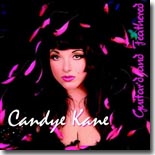 Candye Kane has released several discs over the past decade and a half
and is becoming known as one of the most powerful and entertaining
female blues singers of her generation. She displays an impressive
versatility, easily moving from rollicking jump blues to steamy torch
songs to country punk to gritty blues rock. A few years ago, she settled
in with Ruf Records and each subsequent disc has surpassed its
predecessor. Her most recent, Guitar’d and Feathered, is no exception.
Candye Kane has released several discs over the past decade and a half
and is becoming known as one of the most powerful and entertaining
female blues singers of her generation. She displays an impressive
versatility, easily moving from rollicking jump blues to steamy torch
songs to country punk to gritty blues rock. A few years ago, she settled
in with Ruf Records and each subsequent disc has surpassed its
predecessor. Her most recent, Guitar’d and Feathered, is no exception.
Guitar’d and Feathered finds Kane teaming up with a veritable Who’s Who
of blues guitarists, including Bob Margolin (who also produced), Junior
Watson, Bob Brozman, Jeff Ross, Sue Foley, Ana Popovic, Kid Ramos, Heine
Andersen, Dave Alvin, and Popa Chubby. While their presence is more than
welcome, this is clearly Ms. Kane’s show. She’s never sounded better. In
addition, she had a hand in writing seven of the 13 tracks on the
disc.
Similarly to Kane’s other releases, there’s a variety of styles present
ranging from the jumping opener, “My Country Man” (featuring Watson’s
tasty guitar) to the country blues of “Back With My Old Friends,” backed
by Margolin and Alvin to the rocking cover (thanks to Margolin and
Foley) of Guitar Slim’s “I Done Got Over It.” The soulful “Goodbye My
Heart” features Kane’s regular guitarist Heine Andersen, as does the
self-depreciating Motownish “I’m My Own Worst Enemy.”
Other highlights include the country-tinged “Fine Brown Frame,” where
Kane is accompanied by Kid Ramos on acoustic guitar, the blues rocker
“I’m Lonely,” and the jazzy “We’re Long Ago and Far Away,” where
Margolin lends solid support.
Kane’s previous CDs, and her live performances, have featured a few
ribald moments, but on Guitar’d and Feathered, she plays it pretty
straight for the most part. However, the closing tune, “Crazy Little
Thing,” a lusty rockabilly song with a twist, should satisfy longtime
fans.
Kane also gets terrific support from pianist Sue Palmer, Bill Stuve on
bass, Billy Watson on harmonica, Tommy Yearsley on B-3, and her son Evan
Caleb on drums. Guitar’d and Feathered is a strong effort by Candye
Kane, maybe her strongest yet. If you’ve missed out on her talents so
far, this is a great place to start.
--- Graham Clarke
 The Beat Daddys have built a loyal group of fans around the southeastern
part of the U.S. with their brand of rough and tumble blues-rock. Having
built a solid catalog during the ’90s (including a couple with the
former Malaco subsidiary Waldoxy), the Beat Daddys were driven from
their stomping grounds on the Mississippi Gulf Coast when Hurricane
Katrina destroyed most buildings near the coastline, including lead
guitarist/singer Larry Grisham’s home in Pass Christian. Devastated by
the loss, Grisham moved to Nashville and proceeded to put together a new
recording.
The Beat Daddys have built a loyal group of fans around the southeastern
part of the U.S. with their brand of rough and tumble blues-rock. Having
built a solid catalog during the ’90s (including a couple with the
former Malaco subsidiary Waldoxy), the Beat Daddys were driven from
their stomping grounds on the Mississippi Gulf Coast when Hurricane
Katrina destroyed most buildings near the coastline, including lead
guitarist/singer Larry Grisham’s home in Pass Christian. Devastated by
the loss, Grisham moved to Nashville and proceeded to put together a new
recording.
The Beat Daddys’ sixth and latest release, Five Moons, will be a treat
to their longtime fans. In addition to his muscular vocals, Grisham is a
first-rate composer. He penned all 12 tracks, most of which focus on
the familiar blues themes – good times, heartbreak, and love gone bad.
Lead guitarist Britt Meacham is best known for playing guitar on the Bob Seger classic, “Old Time Rock & Roll,” and lays down some mighty fine
guitar on this set.
Standout tracks include the smoking opening cut, “Pale White Circle,
“Been There, Liked That” (which features some strong harp by Grisham and
), the slow burner “Everybody Needs Some,” and the title cut, which
features Grisham and Meacham on acoustic guitars. “Lonely Road” sounds
like a long-lost Seger album track.
Meacham never fails to impress with one dazzling solo after another,
particularly on “Everybody Needs Some” and “Call Me Back,” and “Where Is
She.” Supplying solid support is the rhythm section of Barry Bays
(bass), Paul Scott (drums) with assistance on several tracks by David
Parks (drums), Dennis Gulley (bass) and Allman/Betts alum Johnny Neel
(keyboards).
Five Moons is an outstanding return for the Beat Daddys and should
please their longtime fans as well as fans of authoritative blues rock.
It’s good to have these guys back on the recording scene. Go to their
website (www.beatdaddys.com) for more information on them and to check
out their other recordings.
--- Graham Clarke
Adam Posnak is a singer/guitarist based in the Ozark Mountains in
Arkansas. He’s also an artist and makes up half of the roots duo Uncle
Cuckleburr’s Champion Possum Carvers. Influenced by his father’s record
collection, which contained albums by Leadbelly, Little Richard, Howlin’
Wolf, and Jerry Lee Lewis, Posnak has released Ragged and Dirty, a
collection of Posnak’s interpretations of 12 traditional blues
songs.
Posnak recorded the disc live in a century-old farmhouse in the Ozarks,
with only one overdub. He plays 6 and 12-string and National guitar with
commanding dexterity and his vocals are ragged and craggy, perfectly
suited for the material, which includes familiar tunes like “C.C.
Rider,” “Fallin’ Down,” “Willie Mae Blues,” “Boweevil Blues,” and “M & O
Blues.” The lone non-traditional song is “Obeah Wedding,” which is a
pretty smooth fit with the older songs. Posnak plays it pretty straight
on these tracks. Though he is playing electric guitar on most tracks, it
doesn’t stray or distract from the acoustic origins of the songs at all.
Ragged and Dirty is an enjoyable, well-played set of standard blues
classics and while they won’t make you forget the originals, they stand
up pretty well next to them. Fans of well done pre-war blues will enjoy
this set. For more information on Adam Posnak, contact him at
aposnak@hotmail.com,
or go to his website,
www.myspace.com/adamposnak.
--- Graham Clarke
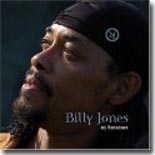 My Hometown (Black & Tan Records) is a representative of a newer generation of our music, which
Billy Jones calls “Bluez.” From somewhere in Arkansas (there seems to be
hundreds of different regional styles within its musical borders), his
hometown is mysterious. He is interested in “advancing/extending ‘Great
Black Music from the Ancient to the Future’ and making sure that it is
available for future generations.”
My Hometown (Black & Tan Records) is a representative of a newer generation of our music, which
Billy Jones calls “Bluez.” From somewhere in Arkansas (there seems to be
hundreds of different regional styles within its musical borders), his
hometown is mysterious. He is interested in “advancing/extending ‘Great
Black Music from the Ancient to the Future’ and making sure that it is
available for future generations.”
Easy, acoustic guitar patterns and chords usher in an instantly welcome
feeling. Soon, string effects give way to vocals providing a Bill Withers
feel. It’s love music with pop potential, romantic lyrics, plus
attractive patterns and slight hooks. Background vocals are sometimes
wordless, other times repeated. Jones’ vocals are not trained, but
genuine. Tremelo and a train rhythm join for “Pull My 44,” with a good
drummer playing brushes and sticks. Think of it as insurance against
anyone messing with his woman. Not strictly blues so far, but certainly
modern southern and not as in rock. We slow down for a rich “Right Now,”
this one hinting at soul. Of course it’s about love, after all the
whammy bar is utilized on solid-body guitar strings!
By now, the writing and warm production are evident as uniform. It’s
simple enough for the masses but non-commercial enough for purists. Echo
effects on the vocal and now hard-rock-sounding guitar hit home the
crystal meth topic of the next story. Some don’t think music is the
canvas for social commentary, but I’m not among them. The blues
especially has a history of communication, perhaps underground in
earlier generations. Wasn’t it Tommy Johnson singing about drinking
canned heat? Fortunately free speech continues to be revered in music as
symptoms of ageless problems progress. This track is pretty wicked
musically, too.
Over the four following tracks we hear more soul complete with dreamy
tempo, handclaps, middle of the night love talk and electric piano. We
have funk/rock and a topic of forbidden love. One cut has an almost
Spanish acoustic rhythm guitar, while the electric lead hints at
Flamenco. And it’s interesting that authorship of all the selections are
un-credited. The fresh lyrics suggest they are original but what is
described as “a new genre of music that rises from the ashes of what has
come before it” sometimes sounds like a kind of updated Howlin’ Wolf
feel in half-time.
An almost folk setting shows some promise toward the end of the album,
but it quickly gets somewhat syrupy. Not enough to wear out a welcome,
but feeling like the set is winding down, returning to slide guitar. The
peppy closer works, with a long intro vamp on a single chord, going to
the quick change as the vocal starts, “Bluez Comes Callin’,” and this is
indeed a real blues. It’s verified down-home, played without bass and
even a washboard-type effect for an instant, but a little suspect with
over-processed wordless vocal refrain. One thing’s for sure: Billy Jones
CAN’T live without his baby, to whom he’s been singing his heart out on
every selection. We got that.
Great clean, lead guitar playing plus good second guitar are the high
points of this music. Lyrically love is the truth at the top, the ghetto
a secondary recurring theme. Grade of B.
--- Tom Coulson
Radio Broadcaster/Musician
mailto:tcoulson@ktar.com
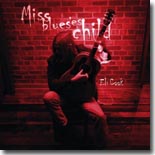 Eli Cook's Miss Blues'es Child (Sledgehammerblues) is strong raw acoustic, but processed slide guitar falls into medium tempo
supported by a single tambourine. A commanding, deep singing voice, à la
Little Ed or maybe Lonnie Brooks, makes obvious it’s not what’s sung, but
the way it’s delivered. This before we even detect it is Robert
Johnson’s classic "Terraplane Blues," a vehicle (pun intended) not always
reliable historically, but this version I actually repeated before going
to track two. It’s that grabbing, doing what an opening number should.
Eli Cook's Miss Blues'es Child (Sledgehammerblues) is strong raw acoustic, but processed slide guitar falls into medium tempo
supported by a single tambourine. A commanding, deep singing voice, à la
Little Ed or maybe Lonnie Brooks, makes obvious it’s not what’s sung, but
the way it’s delivered. This before we even detect it is Robert
Johnson’s classic "Terraplane Blues," a vehicle (pun intended) not always
reliable historically, but this version I actually repeated before going
to track two. It’s that grabbing, doing what an opening number should.
Cook is from Charlottesville, VA, and defies his young age. His taste stems from decades of blues
history and is not overly updated. Definite country complete with porch
effects and banjo identify what has to be an answer to vintage Charly
Patton, “Don't Ride My Pony.” Folky is “Anything You Say,” pleasant and
soulful are the 12-string guitar and vocal. Played solo also is
Leadbelly’s “Goodnight Irene,” plaintive with slide.
On the title track there’s a little sampling in the intro of that same
acoustic slide guitar. The groove is slightly laid back, and lyrics
describe a story of environment that Muddy Waters might sing about
today. The CD is full of obscure covers, one being “Don’t You Mind
People Grinnin’ In Your Face,” done in vocal and foot tap only. The
beginning is equalized to sound like an old 78 RPM and I swear he’s
singing way off-key on purpose. Shades of R.L. Burnside with banjo
instead of drum rhythm are heard in the somewhat hypnotic “Goin’ Down
South.” This same kind of groove is achieved on track 10, “Poor Black
Maddie,” except with solo electric guitar.
Banjo has to be the furthest thing from Jimmy Reed’s simple Chicago
blues style, yet here it adds a wonderful country touch that works.
There’s even crude harmony and a fade after a couple minutes just like a
Reed record. A haunting highway ballad should be a part of any southern
blues program of the last hundred years, and here it cuts to the core,
probably akin more to John Lee Hooker than anyone. Back to 12-string
played hard and exquisitely in almost suspended rhythm on “Trick Bag”
where Cook is moanin' at the midnight hour. Full-out fuzz guitar with the
re-appearing tambourine wrap with the concluding “Fixin’ To Die,” like
Muddy’s “Rollin’ And Tumblin’” with original words. But don’t eject the
CD yet, that ghost-like voice re-appears after half a minute again
grinning in your face, slowly fading back into the dark south. The album
in its entirety is succinct and satisfying.
Grade of B+ with the caveat that modern country blues is not always for
listeners new to the music.
--- Tom Coulson
Radio Broadcaster/Musician
mailto:tcoulson@ktar.com
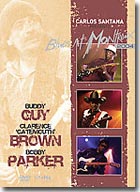 Eagle Vision’s
Live at Montreux DVD series focuses on all music genres.
Like others in the series, Carlos Santana Presents Blues At Montreux
2004, featuring Bobby Parker, Clarence "Gatemouth" Brown
and Buddy Guy, contains high quality
production, professional editing, excellent sound, impressive camera
work, and clever authoring. There are plenty of camera angles (side
stage, on stage, front stage, etc) and none of them are obstructed. All
three concerts – each is on a separate disc – were filmed in wide screen
high definition on July 12, 2004 in the Stravinski Auditorium at the
esteemed festival.
Eagle Vision’s
Live at Montreux DVD series focuses on all music genres.
Like others in the series, Carlos Santana Presents Blues At Montreux
2004, featuring Bobby Parker, Clarence "Gatemouth" Brown
and Buddy Guy, contains high quality
production, professional editing, excellent sound, impressive camera
work, and clever authoring. There are plenty of camera angles (side
stage, on stage, front stage, etc) and none of them are obstructed. All
three concerts – each is on a separate disc – were filmed in wide screen
high definition on July 12, 2004 in the Stravinski Auditorium at the
esteemed festival.
Bobby Parker is likely the least known among the threesome. He is one of
those artists you watch and think, wow, where has he been? Parker is a
DC-based bluesman who, in the 1950s, played rock ’n’ roll guitar behind
Bo Diddley, Sam Cooke, Jackie Wilson, and The Everly Brothers. The
proceedings begin with an instrumental that showcases Parker’s
invigorating band of five members including Dane Paul Russel, who looks
like Peter Green and plays harp like it is a guitar. On "It’s Unfair," he
delivers blazing and ripping lip-singed blown harp. "Break It Up" is
Chicago blues/funk led by Parker’s contemporary blues guitar. He roams
the stage on "Breaking Up Somebody’s Home," yet fails to display any stage
presence. Parker’s vocals, which include James Brown-like screams,
aren’t powerful nor do they contain a lot of range. Parker becomes a bit
monotonous, and sometimes his surging guitar sounds too similar to Buddy
Guy and Roy Buchanan.
Dressed in his typical black and white cowboy shirt, 80-year-old
Clarence ‘Gatemouth’ Brown proves to be a classy and well-rounded
musician. With his fingers, he effortlessly plays versatile guitar. This
concert of 10 upbeat tunes also begins with an instrumental which
reveals Brown’s talented and jazzy sounding four-piece band. There are
no lines drawn between jazz and blues by this impartial group. If you
don’t enjoy sax, keyboard, and guitar solos in every song, you may
become bored with this concert. The enormously sized Eric Demmer toots
his alto sax into the upper stratosphere. He blows it as gentle as a
summer breeze to as fierce as a thunderstorm’s wind. Brown plays fiddle
on the stomping Sunrise Cajun Style. Overall, his instrumentation is
livelier than his vocals. I’ve Got My Mojo Working is unlike all the
overplayed versions of the classic song. Many musical styles are heard
in Gate’s music. The American music icon passed away in September 2005
after Hurricane Katrina destroyed his New Orleans home.
Though Buddy Guy specifically wanted to provide a jazzy set, he does not
deliver a brilliant performance. His sax player, Jason Moynihan, distracts
from the band’s Chicago-sounding blues potential. The best example of
this is when his sax substitutes for the original harmonica on "Hoochie
Coochie Man." Clearly, Guy is in awe of this sax man and claims, “This is
the kind of blues I heard when I first came to Chicago.” This concert
doesn’t seem to have a flow to it and it does not contain enough Buddy
Guy electric guitar. Strangely, Guy opens unaccompanied with three
acoustic numbers when he has never been much of a rhythm guitarist.
Still, Guy maintains his killer smile which could light up the darkest
night. His vocals are as dramatic and dynamic as ever. He has an innate
ability to deliver lyrics like he is telling a story to a friend. His
decimating lead guitar solos range from sluggish to lightening fast
where his pick-held hand oscillates faster than his fret-placed hand.
Ever the showman, Guy banters with the crowd between songs and pulls
wild facial grimaces. As you could have guessed, he walks through the
crowd while playing an extended guitar solo, but instead of the cameras
following him, they continue to film the on stage band members.
This 238-minute, three DVD blues set gets attributed to Carlos Santana,
but like the cover photo, his role is primarily in the background. When
he does join these celebrated artists on 11 of 31 songs, they launch
into ultra-jam mode and its exceptional if you enjoy watching/hearing
multiple guitars getting a groove on.
--- Tim Holek
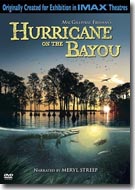 The Mississippi river affects us all. From
my home in the desert, it’s well over 1,400 miles to the bayous of
Louisiana, the home of Tab Benoit. I’ve known Tab going on four
years now, back to when our Blues Society booked him to play our
festival and it was at last year’s Blues Music Awards that we had an
opportunity to talk about a project he was involved with, the IMAX
movie, Hurricane on the Bayou. Conceived by the Audubon
Institute, the project was originally designed to show how the loss of
Louisiana’s wetlands greatly increased the exposure of New Orleans to
damage from a potential category five hurricane. And then Katrina
happened….and the focus of the movie changed dramatically.
The Mississippi river affects us all. From
my home in the desert, it’s well over 1,400 miles to the bayous of
Louisiana, the home of Tab Benoit. I’ve known Tab going on four
years now, back to when our Blues Society booked him to play our
festival and it was at last year’s Blues Music Awards that we had an
opportunity to talk about a project he was involved with, the IMAX
movie, Hurricane on the Bayou. Conceived by the Audubon
Institute, the project was originally designed to show how the loss of
Louisiana’s wetlands greatly increased the exposure of New Orleans to
damage from a potential category five hurricane. And then Katrina
happened….and the focus of the movie changed dramatically.
The movie is slowly being rolled out to
IMAX theaters all around the country, but I had the opportunity to see
the film when I was in Memphis for this year’s BMA’s. I was with my
friend, Laura, a Louisiana native herself, and had the opportunity to
watch the movie through both my eyes and hers. At times we laughed, at
times we were moved to tears; this film is that powerful.
The crux of the wetlands problem is very
simple. For thousands of years the Mississippi river would flood the
farmlands near the Louisiana delta as it approached the gulf and would
deposit the topsoil it carried to form the wetlands. Plants would take
root in the topsoil, anchor it and hundreds of miles of wetlands evolved
along the Louisiana coast. To combat the floods, engineers devised a
series of levees along the river to protect the farms and severely
inhibited the river’s ability to deposit soil into the wetlands. All of
that valuable topsoil now washes straight out to the ocean. Engineers
also dug navigational canals to assist the boat traffic; the canals
brought salt water from the ocean into the wetlands, killing the plant
life whose roots have helped to keep the soil in place. So in the last
50 years, enough of the wetlands have disappeared to equal a land mass
the size of the state of Delaware. The wetlands are important because as
a hurricane works its way inland, each three miles of wetlands reduces
the height of a hurricane surge by a foot. 300 miles of wetlands would
have reduced the height of a hurricane like Katrina by 100 feet, enough
to significantly reduce the damage caused by Katrina and hurricanes like
her.
Tab believes that man’s highest calling is
stewardship of the land he loves and he works tirelessly on behalf of
his beloved Louisiana wetlands to encourage their preservation and
redevelopment, the driving force behind the Hurricane on the Bayou
project.
Hurricane on the Bayou focuses on
the efforts of Louisiana musicians like Tab, Chubby Carrier, Alan
Toussaint, Amanda Shaw and others to spread the word of the importance
of the wetlands. It primarily follows the lives of Tab, Amanda and a
gator in the wetlands as Katrina grows and approaches Louisiana. We’re
introduced to the gator when Tab and Amanda come upon her nest in the
bayou; she’s lying on it to protect the 50-60 eggs that she has laid. As
her brood hatches we’re left to wonder how Katrina will affect them.
When the order is given to evacuate the entire city of New Orleans,
Amanda’s family leaves the Crescent City not knowing where her
grandmother and grandfather are or whether they made it out ok. Tab
himself is on the road, many miles away worrying about his home that is
out in the bayou. Emotions run high as everyone involved is faced with a
unique set of circumstances. All of this drama is cast against the
backdrop of the destruction that Katrina wrecks upon the city of New
Orleans.
I don’t want to delve much further into
the story line of this movie. Its much more important that you see it
for yourself, experience the emotions of artists like Amanda and Tab as
they wrestle with the knowledge that preservation of Louisiana’s
wetlands could have done a great deal to mitigate the damages inflicted
by Katrina. Creative solutions exist that slowly but surely can work to
bring back the nature and beauty of Louisiana’s wetlands. But it will
take a cooperative effort by everyone involved to make it happen. This
is the life work that Tab Benoit has chosen to live for.
Hurricane on the Bayou will come to
an IMAX theater near you soon. Please go see it. The IMAX experience
itself has a much greater visual impact on the filmgoer than the DVD of
the movie that was released June 5th. Both the DVD and a
soundtrack of the movie are available through the website,
hurricaneonthebayou.com and at fine retailers everywhere. Proceeds
from the movie and the soundtrack both help to benefit the Louisiana
wetlands, a very worthy cause.
But Tab himself will tell you that the
best thing you can do to help the Louisiana wetlands is to visit them.
The sites you will see and the benefit your tourist dollars will have on
the economy of Louisiana is enormous. And in the long run what better
way is there for you to show your love and appreciation for the people
of Louisiana than to go to their homes, hear their stories and enjoy
their music. You will appreciate your time spent in Louisiana and be
much richer for it.
--- Kyle Deibler
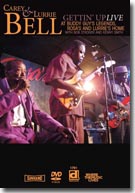 I was at the Delta Blues Museum in
Clarksdale when the word came that we’d lost both Big Joe Duskin and
Carey Bell in the same day. We’ve lost way too many bluesmen this
year and the day was tempered by some great company and a trip to
Hopson’s Commissary and the Shack Up Inn. I’d not seen Carey perform in
person, so it was a rare treat when I got home to receive the Delmark
DVD release, Gettin’ Up Live, and have a chance to see Carey
perform with his son, Lurrie Bell.
I was at the Delta Blues Museum in
Clarksdale when the word came that we’d lost both Big Joe Duskin and
Carey Bell in the same day. We’ve lost way too many bluesmen this
year and the day was tempered by some great company and a trip to
Hopson’s Commissary and the Shack Up Inn. I’d not seen Carey perform in
person, so it was a rare treat when I got home to receive the Delmark
DVD release, Gettin’ Up Live, and have a chance to see Carey
perform with his son, Lurrie Bell.
Getting’ Up Live features
performances at Theresa’s Lounge, Buddy Guy’s Legends and some intimate
home footage shot at Lurrie’s home. Together, the three locations give
the listener/viewer a rare opportunity to catch this harp legend perform
live with his equally talented guitarist son. These sessions were
important to Carey. In his liner notes Bill Dahl talks about the fact
that Carey had endured a stroke and four weeks in the hospital with a
broken hip before he made the car trip back to Chicago for these
sessions. He even wrote a song, "Getting’ Up," to share his happiness at
being able to perform back home in Chicago in front of his friends and
family. The result is an intimate look at one of the most respected
father/son duos we’ve had in the blues.
The session at Rosa’s Lounge opens with
“What My Momma Told Me.” Carey’s harp is ably complimented by Lurrie’s
solo guitar work and the show starts off with a bang. Brian Jones on
drums, Bob Stroger on bass and Roosevelt Purifoy on piano compliment the
playing of Carey and Lurrie. The band is tight, and clearly Carey is
enjoying himself as he surveys the crowd at Rosa’s from his overstuffed
chair. And he lets them know how he feels in his new song, “Gettin’ Up.”
“I’ve been down…..but I’ll get up again….I don’t want you to worry…want
to hang out here with my friends!” Carey is clearly enjoying himself and
Delmark makes use of a split screen shoot to highlight the give and take
between Carey and Lurrie as they exchange solos during this new song by
Carey.
The classic Big Joe Williams song, “Baby
Please Don’t Go,” is next and features a blistering guitar intro by
Lurrie. Scott Cable sits in on guitar for this number and Carey’s vocals
are strong as he pleads for his woman to stay. “Baby….please don’t go…I
need you so….baby, please don’t go….back to New Orleans….I love you so.”
Next up is the torrid “Bell’s Back,” an instrumental that features
extended solos from both Carey and Lurrie that has the crowd at Rosa’s
screaming for more.
Two additional songs recorded at Rosa’s,
“Hard to Leave You Alone” and “I’m a Fool,” are bonus songs included on
the DVD but not included in the CD release. “Hard to Leave You Alone”
features a soulful harp intro by Carey and finds him lamenting his love
for his woman. “You’re so easy to love…and so hard to leave alone…You
know I’m not satisfied…until I hold you in my arms.” The despairing
tones of Carey’s harp are complimented by a wonderful guitar solo by
Lurrie as Carey shares his pain at loving this woman. “I’m a Fool”
closes out the session at Rosa’s and has Carey admitting the error of
his ways, “I’m a fool…fool…fool….I’m an old fool” Clearly he’s made the
wrong choice in terms of this woman and realizes the error of his ways.
Joe Thomas takes over for Bob Stroger on
bass and Kenny Smith has the drums for the sessions filmed at Buddy
Guy’s Legends. The band kicks off the set with “One Day.” “One day,
baby…you’re going to get as lucky as can be….that will be the day…you
find out what I need…I just want to love you….hold you in my arms.”
“Leaving in the Morning” follows and features Carey exchanging harp
solos with Roosevelt Purifoy on the piano. The song ends, and I’m
touched when Carey leans over to Roosevelt and says, “Not Bad,” at the
end of the song acknowledging his keyboard work. Another Little Walter
song, “Last Night,” finds Carey sharing his emotions via some poignant
harp work as he sings, “Last night….I lost the best friend that I ever
had….girl did I love you…don’t you know you’re my end?” A passionate
guitar solo by Lurrie compliments the sadness that Carey feels at losing
this girl that he loved so much.
The set at Buddy Guy’s concludes with “Low
Down Dirty Shame.” We find Carey at a point in his relationship where
his woman is off with another man. “I don’t care what you do… I love you
just the same.” The highlight of “Low Down Dirty Shame” is the face to
face exchange of solos at the end between Carey and Lurrie as each
watches the other intently to know when to play next.
I find the footage shot at Lurrie’s house
to be the most revealing. Perched on the couch with cushions placed for
his comfort, Carey gives us some of the most intimate songs of the DVD.
“Broke and Hungry,” the classic Sleepy John Estes tune, is followed by
“When I Get Drunk.” Both find Carey in fine form and his harp work is
passionate and sincere. “When I get drunk….I think about that little
girl of mine…..I think about her all the time.” “Short Dress Woman”
finds Carey reflecting on the trouble his woman will get into as her
skirt rises. “Wearing the short dress girl…way above your knees…wearing
that short dress girl…for anybody you please.” The DVD concludes with
Lurrie’s only vocal performance, the traditional “Stand By Me.”
Fans of both Carey and Lurrie will
appreciate Gettin’ Up Live. Musically, this is a wonderful
recording of them together with a tight supporting cast that enables
father and son to showcase their wonderful talents. I’m glad that
Delmark sent me theDVD to review because of the intimate look it
provided into the relationship between Carey and Lurrie. I’m saddened by
one of the extra features, an interview with Carey and Lurrie. Lurrie
spoke of the joys of living for his child and lovely wife, Susan, only
to have lost Susan to lymphoma this past January and now his father as
well. This has been a year to test the faith of Lurrie Bell, and my
heart goes out to this Chicago bluesman. Brighter days are coming,
Lurrie, and all my best to you and your family.
--- Kyle Deibler
I was in Memphis for the BMA’s and caught
the end of an Inside Sounds showcase when Keith Soltys, the A&R rep for
Daddy-O Records came up to say hello and tell me about Billy Gibson’s
new record, Live at the Rum Boogie. My ears perked up; the Rum
Boogie is my home away from home and Billy has ruled the roost on Beale
Street from there for a number of years as the house band for the
Boogie. What a perfect combination --- the KBA Blues Club of the Year
for 2007 and one of last year’s BMA nominees for newcomer of the year!
The result is a combustible live record that attempts to capture the
essence of Billy live on Beale Street. I think if I turn the volume up
high enough, it just might take me there.
Billy opens up with his Mississippi
saxophone blistering as he leads off with the self-penned “What is
Love.” “What is love baby…well honey I just don’t know…maybe my momma
was right…you’re going to reap just what you sow.” In my mind's eye I
see the patrons of the Boogie up dancing on the uneven dance floor that
is part of the charm of the club. The energy of this recording is high
and you can imagine that it was a hot night at the Rum Boogie. A tight
bass line put down by James Jackson leads into the next tune, “Love
Everybody,” as Billy welcomes the crowd to the evening’s festivities.
“You’ve got to love everybody you know…in out of your neighborhood…you
know my one wish for you baby is that you love me from the start!”
Billy’s in rare form on his harp and the beauty of this live record is
the extended solo opportunities of which he takes advantage.
Cedric Keel on drums kicks off the
introduction to a classic Willie Dixon song, “Pretty Thing.” His steady
bass drum backbeat keeps everything in line as Billy croons, “Oh you
pretty thing….I want you here right by my side…won’t you be my blushing
bride…well, oh…you pretty thing!” Tight fret board work by David Bowen
punctuates the introduction to “Home at Last (A.K.A. Country Girl).”
“Every time my baby walks you know she upsets every man she meets…Lord
knows I hate to see my baby…you know when she walks up and down Beale
Street.” She may be a country girl but you can bet she’s beautiful and
everyone on Beale Street knows it.
Billy’s back on his harp as the band
swings into the introduction for “Darling Please Come Home.” The tone of
his harp is apologetic as he pleads his case, “you know I thought I
didn’t care…and I thought I wouldn’t cry…but every night I cry for
you….but alone is what I am, so honey won’t you please come home?” This
sounds like Billy let a good one get away and came to the realization
too late what a good woman she was. Mournful intonations from his harp
lend a sense of desperation for the pain Billy is feeling for letting
her go.
A tight bass line introduces us to “Bad
Boy,” as Billy lets the crowd at the Rum Boogie know that they are a
part of a live recording and “Don’t be afraid to make some noise!” A
blistering harp solo follows and crowd noise in the background lets you
know they are at the Boogie in force. In the meantime Billy lets us know
he’s no saint. “You know I’m a bad boy, baby...and such a long, long way
from home…you know sometimes where I stay….hey that’s the place I call
my home!” Billy, David, James and Cedric are in rare form tonight and
it’s apparent that this is a band that has been together for a long run
on Beale Street.
Billy’s back cranking up his harp as the
band heads into the next cut, “Early in the Morning,” by John Lee
Williamson. “Hey, when a girl reach the age of 18…that’s when she begins
to think she’s grown….you know that’s the kind of girl, yes it is…that
you can never find at home….come see me in the morning…hey baby, just
before the break of day…wish you could see me hug that pillow…you know
it was the one where my baby used to lay.” Billy’s head is in a tizzy
over the charms of a sweet young thing and he’s lamenting the one he
lost who looked like her. The band chooses to close this live recording
with its rendition of “Polk Salad Annie,” and David Bowen takes the
microphone for the lead vocal on this final cut. “Everybody says it was
a shame…her poppa was working on the chain gang!” Billy’s harp provides
a nice contrast to David’s vocals and the band ends the night in great
shape.
Live at the Rum Boogie contains
eight songs that span almost 70 minutes in total recording time as Billy
Gibson and his band mates take advantage of the live recording format to
just let everything rip. It’s nice to hear a live record for a change
where you can tell that everyone at the Boogie had a great time, the
band played its rear end off and the net result is a live recording that
kicks. I would be remiss if I did not mention Robbie Rose, the sound
woman at the Boogie. Night in and night out she manages to coax amazing
sounds out of every band that plays there and I love working with her
when I’m in Memphis. She helped get the best out of Billy and the band
for this recording and her work shows.
This is a party record. Billy and the band
are having a great time and when you put this one in the CD player, turn
it up loud!! It’s not quite like being at the Boogie in person, but its
close.
--- Kyle Deibler
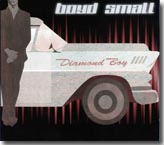 Boyd
Small is a man renowned in blues circles for his drumming and vocals – a
blues equivalent to Phil Collins, if you like.
I have to admit that, although I knew of him, I didn’t know much about
him, until now.
I now find that he played drums with Jimmy Rogers, Screamin’ Jay
Hawkins, Hubert Sumlin, Guitar Shorty and Pinetop Perkins, so he’s had
some very good experience.
Boyd
Small is a man renowned in blues circles for his drumming and vocals – a
blues equivalent to Phil Collins, if you like.
I have to admit that, although I knew of him, I didn’t know much about
him, until now.
I now find that he played drums with Jimmy Rogers, Screamin’ Jay
Hawkins, Hubert Sumlin, Guitar Shorty and Pinetop Perkins, so he’s had
some very good experience.
So, why haven’t we heard much of this Portland, Oregon musician?
He previously released three CDs on the Cool Buzz record label since
relocating to Amsterdam, Holland – and as good as those CDs were, his
new one, Diamond Boy (Me & My Records) is the one to have.
Five of the 11 tracks are originals, written by Boyd Small, the others
are some carefully chosen covers of tracks by Jimmy Rogers,Johnny Otis,
Big Joe Turner, Hubert Sumlin and J.T.Meire, plus a trad blues “Glad Rags”
which opens the album.
The Jimmy Rogers track, “Lemon Squeezer,” follows and it really is a
superb, faultless, version – slow & moody, with some fine bass playing
by Willy Barber and some incredible guitar work.
Unfortunately, this brings me to the only criticism of the CD, and it’s
a very small one!
There are four guitarists listed in the CD notes, but nothing to say
which one plays on which track – and that’s a shame, as all the guitar
work on this CD is top of the range.
Unusually, for an album that’s split between originals and covers, the
originals are, in some cases, better than the covers.
That says a lot for the song writing skills of Boyd Small, as well as
for the musical ability of the band.
Track six, “Del Ray,” is a slow blues with an insistent beat from the drums
and bass going on and some good guitar work – this is maybe the best of
the originals, but in my view there isn’t a bad one.
The best of the covers has to be Hubert Sumlin’s “Look Don’t Touch,” with
it’s strong, foot-tapping, boogie beat – this is excellent stuff!
The Jimmy Rogers song, “Lemon Squeezer,” comes a very close
second.
Let’s hope we hear more from Boyd Small & his band in the near future.
---
Terry Clear
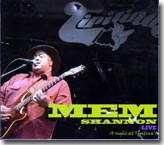 I’ve been a fan of Mem Shannon’s ever
since a friend brought his CD, 2nd Blues Album, back from a
trip to the USA. There have been a few more since then, with A Night
At Tipitina (NorthernBlues), being his
sixth one altogether.
I’ve been a fan of Mem Shannon’s ever
since a friend brought his CD, 2nd Blues Album, back from a
trip to the USA. There have been a few more since then, with A Night
At Tipitina (NorthernBlues), being his
sixth one altogether.
This man is always different, but
consistently good – this particular album isn’t his bluesiest by far,
but it probably is his funkiest! The music is a mix of blues, funk and
soul, with Shannon’s distinctive voice percolating through and
driving things along.
The album comprises eight original tracks,
plus one by Tom Petty and one by the Neville Brothers – a good mix of
music. The Tom Petty track, in particular, is a real surprise. It’s bluesy, and a real change from the
original, although it doesn’t lose the original flavour – Tom Petty’s
song is still there. Before I heard this, I couldn’t imagine a
Tom Petty track being adapted in this way, but this works, and it works
well – good choice! The other cover version – “Voodoo” by the
Neville Brothers – is more jazz-funk than blues, but well adapted to
Shannon’s style.
The album opens with the Mem Shannon
original “Payin’ My Dues,” a funky blues with some lovely guitar work
and a driving backing by the horn section of Joe Cabral, Tim Green and
Jason Mingledorf – it gives the listener a flavour of what’s to come,
and you can tell that the live audience were enjoying themselves.
Unfortunately, for blues fans, the flavour
becomes slightly less bluesy and slightly more funky as the album
progresses. There are one or two exceptions, but soul
and funk are the order of the day here.
Technically, and musically, this is a very
good album – it’s a shame there isn’t more blues in it.
--- Terry Clear